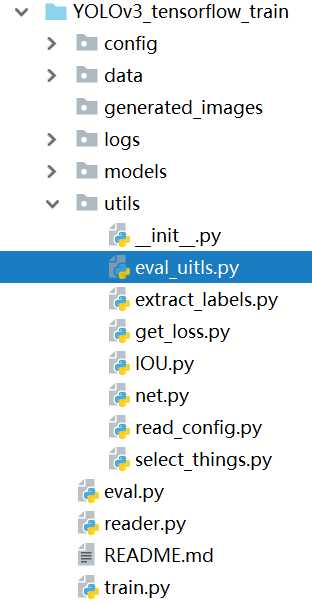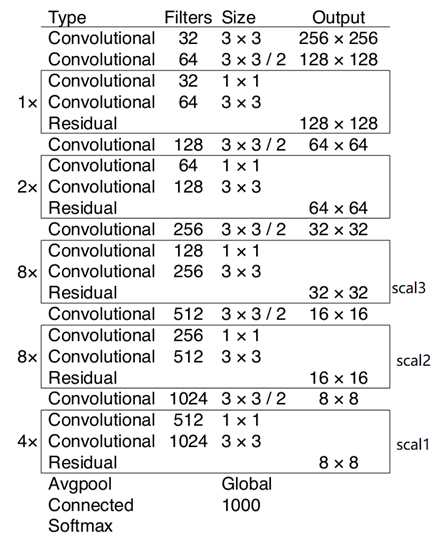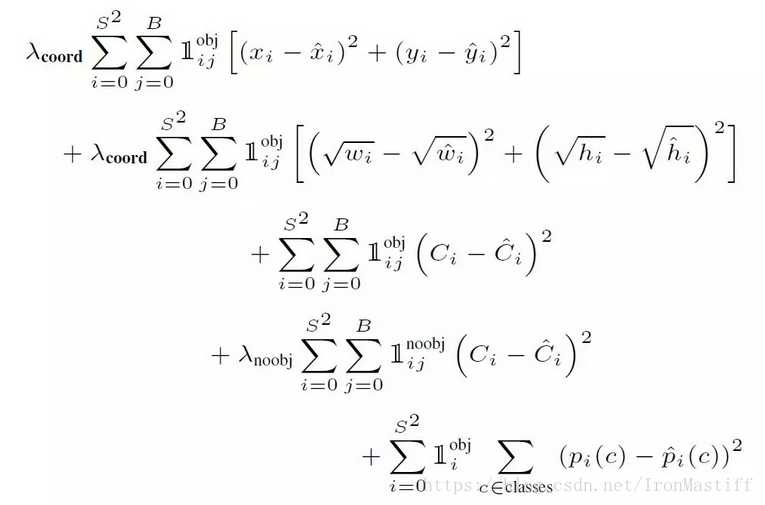标签:ras nim 尺度 返回 cat tps 理解 read yml
看到有人使用tensorflow复现了yoloV3,来此记录下代码阅读。感觉复现的代码写的不是很好,会加一部分其他人用keras复现的代码。
tensorflow代码地址:https://blog.csdn.net/IronMastiff/article/details/79940118
源代码分为以下几部分:
Train.py为主程序train.py部分为训练自己的数据集,eval.py为利用训练好的权重来进行预测。Reader为读取数据标签等,config.yml为训练过程中的一些参数设置,eval_config.yml为预测过程中的一些参数设置。Utils包为其中的一些网络结构,IOU等中间步骤。下面先介绍utils的中的程序

Net.py: 设置网络结构,提取图片信息。Darknet-53网络结构如下。1x,2x等分别表示该结构重复了1次两次等,Residual表示和前面方框外的结构进行按维度叠加,类似于残差网络。
feature_extractor 函数该提取三个尺度的信息scale1,scale2,scale3,分别为倒数第1,2,3个方框中网络结构的输出。之后,scales函数通过1x1,3x3卷积分别对三个尺度的特征单元进行特征交互。返回交互后的三个尺度信息。
最后输出的三个不同尺度分别为 13X13X75,26X26X75,52X52X75具体交互信息可参考代码结构。最后训练时会选取不同scale参与计算loss,select_things就是选取不同scale的特征。
不太理解如何使用?是需要手动更改配置文件的scale选择?如何选择?

IOU.py 为NMS筛选anchor,用来参与最后的loss计算get_loss.py.先来解释IOU
1 def IOU_calculator( x, y, width, height, l_x, l_y, l_width, l_height ): 2 ‘‘‘ 3 x,y,width,height分别为预测框的中心坐标及宽,高,l_x, l_y, l_width, l_height分别为真实框的中心坐标及宽,高 4 ‘‘‘ 5 ##x_min=x-w/2,y_min=y-h/2,x_max=x+w/2,y_max=y+h/2 此段意义为分别求出四个角坐标 6 x_max = calculate_max( x , width / 2 ) 7 y_max = calculate_max( y, height / 2 ) 8 x_min = calculate_min( x, width / 2 ) 9 y_min = calculate_min( y, height / 2 ) 10 11 l_x_max = calculate_max( l_x, width / 2 ) 12 l_y_max = calculate_max( l_y, height / 2 ) 13 l_x_min = calculate_min( l_x, width / 2 ) 14 l_y_min = calculate_min( l_y, height / 2 ) 15 16 ‘‘‘求相交部分的面积‘‘‘ 17 xend = tf.minimum( x_max, l_x_max ) 18 xstart = tf.maximum( x_min, l_x_min ) 19 20 yend = tf.minimum( y_max, l_y_max ) 21 ystart = tf.maximum( y_min, l_y_min ) 22 23 area_width = xend - xstart 24 area_height = yend - ystart 25 26 ‘‘‘IOU=A & B/(A+B-A & B)若A与B交集为0,则返回1e-8‘‘‘ 27 area = area_width * area_height 28 29 all_area = tf.cond( ( width * height + l_width * l_height - area ) <= 0, lambda : tf.cast( 1e-8, tf.float32 ), lambda : ( width * height + l_width * l_height - area ) ) 30 31 IOU = area / all_area 32 33 IOU = tf.cond( area_width < 0, lambda : tf.cast( 1e-8, tf.float32 ), lambda : IOU ) 34 IOU = tf.cond( area_height < 0, lambda : tf.cast( 1e-8, tf.float32 ), lambda : IOU ) 35 36 return IOU
get_loss.py为计算损失函数,他的损失函数计算是按照yolov1来计算的,有点问题。

1 def objectness_loss( input, switch, l_switch, alpha = 0.5 ): 2 ‘‘‘ 3 input为IOU,switch为若预测该框内有object则为1,否则为0,l_switch为实际该框有object则为1,否则为0 4 ‘‘‘ 5 6 IOU_loss = tf.square( l_switch - input * switch ) ##input * switch类别置信度C 7 loss_max = tf.square( l_switch * 0.5 - input * switch ) 8 9 IOU_loss = tf.cond( IOU_loss < loss_max, lambda : tf.cast( 1e-8, tf.float32 ), lambda : IOU_loss ) 10 11 IOU_loss = tf.cond( l_switch < 1, lambda : IOU_loss * alpha, lambda : IOU_loss ) 12 13 return IOU_loss 14 15 def location_loss( x, y, width, height, l_x, l_y, l_width, l_height, alpha = 5 ): 16 point_loss = ( tf.square( l_x - x ) + tf.square( l_y - y ) ) * alpha 17 size_loss = ( tf.square( tf.sqrt( l_width ) - tf.sqrt( width ) ) + tf.square( tf.sqrt( l_height ) - tf.sqrt( height ) ) ) * alpha 18 19 location_loss = point_loss + size_loss 20 21 return location_loss 22 23 def class_loss( inputs, labels ): 24 classloss = tf.square( labels - inputs ) 25 loss_sum = tf.reduce_sum( classloss ) 26 27 return loss_sum
接下来是提取训练数据的程序extract_labels.py 可下载pascal voc数据集,对照数据的格式来读数据。比较麻烦,但是这个也是训练程序与预测程序最大的不同点,这份代码最大的亮点也在此,其他部分实现个人感觉并不是很好。数据既可以读取类别标签,也可读取物体框的信息。
粗略的写了一份程序解读,因为只能找到一个tensorflow代码实现,个人认为不是很好,希望有人有比较好的复现可以说一下。同时学好C++很重要呀,就可以直接读取源码了。
标签:ras nim 尺度 返回 cat tps 理解 read yml
原文地址:https://www.cnblogs.com/the-home-of-123/p/9733855.html